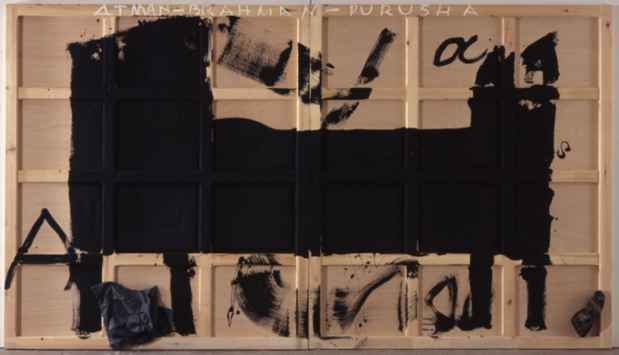Antoni Tàpies “Transmaterial”
Pace Gallery (540 W 25th St.)

[Image: Antoni Tàpies "Atman" (1996) © Antoni Tàpies/Artist Rights Society (ARS), New York.]
This event has ended.
Pace presents an exhibition of work by Antoni Tàpies, who made an indelible mark on the history of art in postwar Europe, North America, and Asia, at its 540 West 25th Street gallery from September 16 to October 22. The presentation, titled Antoni Tàpies: Transmaterial, will take place on the eve of the centenary of the Catalan Spanish artist’s birth. It will showcase some 20 paintings created by Tàpies between the 1990s and early 2000s—Pace has represented the artist for 30 years, and almost all the works in this show were created after Tàpies joined the gallery. Marking the first exhibition dedicated to the artist to be staged at Pace’s New York gallery since 2015, the presentation spotlights Tàpies’s meditative approach to art making, shedding light on the later years of his life and career. The exhibition is curated by Natasha Hébert, the artist’s daughter-in-law.
Born in Barcelona in 1923, Tàpies was a self-taught artist who developed a unique visual language centering on exchanges among symbols, gestures, and materials. The artist, also a celebrated theorist and philosopher, incorporated signs and symbols from Catalonia and other cultures into his paintings, collages, and sculptures, imbuing his work with historical allusions and references to phenomena of the natural world. Mysterious and transcendent, Tàpies’s work, which is replete with personal resonances as well as references to political and social struggles in his native Catalonia and Spain, charted new frontiers in painting during the postwar era.
Over the course of his seven-decade career, Tàpies pursued tireless investigations of forms and raw materials. The artist’s inventive, idiosyncratic combinations of media as diverse as wood, dirt, spray paint, cardboard, blankets, clothes, carpet, furniture, and marble dust reflect his intense interest in experimentation. Tàpies forged complex layers of materials like these in his compositions, bringing striking amalgams of color and texture to the fore of his work. His reimagination and redefinition of painting as a highly physical undertaking would inspire future generations of artists, including major figures working today.
The artist participated in the Venice Biennale exhibitions in 1952, 1954, and 1958 before being chosen to represent Spain at the 45th edition of the Biennale in 1993, when he won the Golden Lion for his large-scale installation titled Rinzen. In 1984, the artist established the Fundació Antoni Tàpies in Barcelona—which opened a museum and library in 1990—to support the exhibition of his work and that of other modern and contemporary artists. Along with the Fundació Joan Miró and Museu Picasso, the Fundació Antoni Tàpies remains a key cultural institution in the fabric of the Spanish city.
Today, Tàpies’s work can be found in the collections of the Museum of Modern Art, New York; the Guggenheim Museum, New York; the Baltimore Museum of Art; the Museum of Fine Arts, Houston; the San Francisco Museum of Modern Art; the Museu Nacional d’Art de Catalunya, Barcelona; the Museo Nacional Centro de Arte Reina Sofía, Madrid; Tate, London; the Stedelijk Museum, Amsterdam; the Centre Pompidou, Paris; the Kunstmuseum Basel; the Städel Museum, Frankfurt; the Museum Ludwig, Cologne; the Tehran Museum of Contemporary Art; the National Gallery of Victoria, Melbourne; and many other international institutions.
The works in Pace’s forthcoming presentation exemplify Tàpies’s interest in enactments of transgression and erasure as well as explorations of the aging body, sex, and death in his art. Among the highlights in the exhibition are the large- scale painting Soc terra (2004), which includes enigmatic plays of spray paint, pencil, and soil on canvas; Manta amb petjades (2001), a painting on a blanket glued on wood; and the painting Mitjons negres (2010), created just two years before the artist’s death in 2012. These and other works in the exhibition reflect Tàpies’s longtime pursuit of visual and spiritual transfiguration and transformation.
Concurrently, Nahmad Projects in London will present antoni tàpies: alchemy, an exhibition of works by Tàpies on view from October 7 to December 16. In this presentation, the gallery will showcase 14 works created by Tàpies between 1952 and 2009, pinpointing the period when the artist distanced himself from figurative compositions and fully immersed in texture and matter.
Antoni Tàpies (b, 1923, Barcelona; d. 2012, Barcelona) is recognized as one of the leading artistic voices to emerge from postwar Europe. Working in parallel with global art movements including Abstract Expressionism, Gutai, Art Informel, Tachisme, and Arte Povera, Tàpies believed that his era required a new kind of existential expression. Influenced by Surrealist methods while a member of the avant-garde Dau al Set group in postwar Barcelona, he came to develop a unique form of automatism and to reject representation and the illusionistic picture plane. He incorporated unconventional media such as textiles, straw, detritus, and found objects into his work, accentuating their tactile and material nature. Their earthy, distressed surfaces relate to themes of entropy and decay, challenging the viewer to find beauty in what is typically overlooked. Tàpies’s oeuvre resides between figuration and abstraction, matter and mysticism, as manifested through his painting, sculpture, drawing, collage, and printmaking.
Media
Schedule
from September 16, 2022 to October 22, 2022